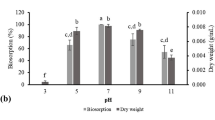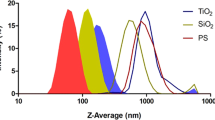Abstract
Research on the toxicity of carbon nanotubes has focused on human health risks1, and little is known about their impact on natural ecosystems2. The ciliated protozoan Tetrahymena thermophila has been widely studied3,4 by ecotoxicologists because of its role in the regulation of microbial populations through the ingestion and digestion of bacteria5,6,7, and because it is an important organism in wastewater treatment and an indicator of sewage effluent quality8. Here we show that single-walled carbon nanotubes are internalized by T. thermophila, possibly allowing the nanotubes to move up the food chain. The internalization also causes the protozoa to aggregate, which impedes their ability to ingest and digest their prey bacteria species, although it might also be possible to use nanotubes to improve the efficiency of wastewater treatment8,9,10,11,12,13,14,15,16.
This is a preview of subscription content, access via your institution
Access options
Subscribe to this journal
Receive 12 print issues and online access
$259.00 per year
only $21.58 per issue
Buy this article
- Purchase on Springer Link
- Instant access to full article PDF
Prices may be subject to local taxes which are calculated during checkout




Similar content being viewed by others
References
Warheit, D. B. What is currently known about the health risks related to carbon nanotube exposures? Carbon 44, 1064–1069 (2006).
Moore, M. N. Do nanoparticles present ecotoxicological risks for the health of the aquatic environment? Environ. Int. 32, 967–976 (2006).
Jacobs, M. E. et al. The Tetrahymena thermophila phagosome proteome. Eukaryot. Cell 5, 1990–2000 (2006).
Turkewitz, A. P. Out with a bang! Tetrahymena as a model system to study secretory granule biogenesis. Traffic 5, 63–68 (2004).
Hahn, M. W. & Hofle, M. G. Grazing of protozoa and its effect on populations of aquatic bacteria. FEMS Microbiol. Ecol. 35, 113–121 (2001).
Jurgens, K. & Matz, C. Predation as a shaping force for the phenotypic and genotypic composition of plantktonic bacteria. Anton. Leeuw. Int. J. G. 81, 413–434 (2002).
Sherr, E. B. & Sherr, B. F. Significance of predation by protists in aquatic microbial food webs. Anton. Leeuw. Int. J. G. 81, 293–308 (2002).
Esteban, G., Tellez, C. & Bautista, L. M. The indicator value of Tetrahymena thermophila populations in the activated-sludge process. Acta Protozool. 31, 129–132 (1992).
De Figueirdo, G. M., Nash, R. D. M. & Montagnes, D. J. S. The role of the generally unrecognized microprey source as food for larval fish in the Irish sea. Mar. Biol. 148, 395–404 (2005).
Power, M. E. et al. Development of a fluorescent multiwell assay for evaluating the capacity of the ciliated protozoan Tetrahymena for bacterivory in water samples. Water Qual. Res. J. Canada. 41, 307–315 (2006).
Elliott, A. M. & Clemmons, G. L. An ultrastructural study of ingestion and digestion in Tetrahymena pyriformis. J. Protozool. 13, 311–323 (1966).
Zhu, Y., Ran, T., Li, Y., Guo, J. & Li, W. Dependence of the cytotoxicity of multi-walled carbon nanotubes on the culture medium. Nanotechnology 17, 4668–4674 (2006).
Hyung, H., Fortner, J. D., Hughes, J. B. & Kim, J. H. Natural organic matter stabilizes carbon nanotubes in the aqueous phase. Environ. Sci. Technol. 41, 179–184 (2007).
Mueller, N. C. & Nowack, B. Exposure modeling of engineered nanoparticles in the environment. Environ. Sci. Technol., doi: 10.1021/es7029637 (2008).
Tiedtke, A. Capsule shedding in Tetrahymena. Naturwissenschaften 63, 93 (1976).
Arregui, L., Serrano, S., Linares, M., Perez-Uz, B. & Guinea, A. Ciliate contributions to bioaggregation: laboratory assays with axenic cultures of Tetrahymena thermophila. Int. Microbiol. 10, 91–96 (2007).
Nilsson, J. R. Retention of lead within the digestive vacuole in Tetrahymena. Protoplasma 95, 163–173 (1978).
Scott, S. M. & Hufnagel, L. A. The effect of convanavalin A on egestion of food vacuoles in Tetrahymena. Exp. Cell Res. 144, 429–441 (1983).
Brandl, M. T., Rosenthal, B. M., Haxo, A. F. & Berk, S. G. Enhanced survival of Salmonella enterica in vesicles released by a soilborne Tetrahymena species. Appl. Environ. Microbiol. 71, 1562–1569 (2005).
Rupper, A. & Cardelli, J. Regulation of phagocytosis and endo-phagosomal trafficking pathways in Dicytostelium discoideum. BBA-GEN. Subject 1525, 205–216 (2001).
Pinheiro, M. D. O. et al. Using Tetrahymena thermophila to study the role of protozoa in inactivation of viruses in water. Appl. Environ. Microb. 73, 643–649 (2007).
Mayor, S. & Pagano, R. E. Pathways of clathrin-independent endocytosis. Nat. Rev. Mol. Cell Biol. 8, 603–612 (2007).
Posch, T. & Arndt, H. Uptake of sub-micrometre- and micrometre-sized detrital particles by bacterivorous and omnivorous ciliates. Aquat. Microb. Ecol. 10, 45–53 (1996).
Wiesner, M. R. Responsible development of nanotechnologies for water and wastewater treatment. Water Sci. Technol. 53, 45–51 (2006).
Forrest, G. A. & Alexander, A. J. A model for the dependence of carbon nanotube length on acid oxidation time. J. Phys. Chem. C 111, 10792–10798 (2007).
Kam, N. W. S., O'Connell, M., Wisdom, J. A. & Dai, H. Carbon nanotubes as multifunctional biological transporters and near-infrared agents for selective cancer cell destruction. Proc. Natl Acad. Sci. USA 102, 11600–11605 (2005).
Acknowledgements
The authors would like to thank D. Weber for his assistance in confocal microscopy, V. Dayeh for helpful discussions, M. Palmer for use of the cell culture laboratory and M.D.O. Pinheiro for assistance in CB assay setup. This work was supported by the startup fund for S.T. from the University of Waterloo. The laboratory of N.C.B. was supported by grants from Earth and Environmental Technologies (ETech) of the Ontario Centres for Excellence (OCE) and the Canadian Water Network (CWN).
Author information
Authors and Affiliations
Contributions
P.G. and X.S.T. conceived and designed the experiments, carried out experiments and data analysis, and co-wrote the paper. C.H.St.D. carried out the colony forming assay, replicated the CB assay, and supplied E. coli-gfp and Tetrahymena stock. M.E.P. carried out initial data acquisition and provided bioassay and instrument training. X.J. carried out AFM characterization of the SWNTs. V.T. carried out the survey and video recording under the contrast phase optical microscope. H.S.M. did EDAX characterization of SWNTs. N.C.B. conceived and designed the experiments, provided material support, co-analysed data and co-wrote the paper. All authors discussed the results and commented on the manuscript.
Rights and permissions
About this article
Cite this article
Ghafari, P., St-Denis, C., Power, M. et al. Impact of carbon nanotubes on the ingestion and digestion of bacteria by ciliated protozoa. Nature Nanotech 3, 347–351 (2008). https://doi.org/10.1038/nnano.2008.109
Received:
Accepted:
Published:
Issue Date:
DOI: https://doi.org/10.1038/nnano.2008.109
This article is cited by
-
Polymer-wrapped single-walled carbon nanotubes: a transformation toward better applications in healthcare
Drug Delivery and Translational Research (2019)
-
Cryptosporidium parvum oocyst directed assembly of gold nanoparticles and graphene oxide
Frontiers of Chemical Science and Engineering (2019)
-
Assessment of agglomeration, co-sedimentation and trophic transfer of titanium dioxide nanoparticles in a laboratory-scale predator-prey model system
Scientific Reports (2016)
-
Effects of fullerene (C60), multi-wall carbon nanotubes (MWCNT), single wall carbon nanotubes (SWCNT) and hydroxyl and carboxyl modified single wall carbon nanotubes on riverine microbial communities
Environmental Science and Pollution Research (2016)



